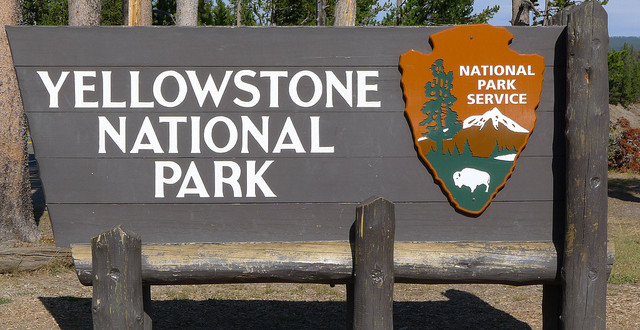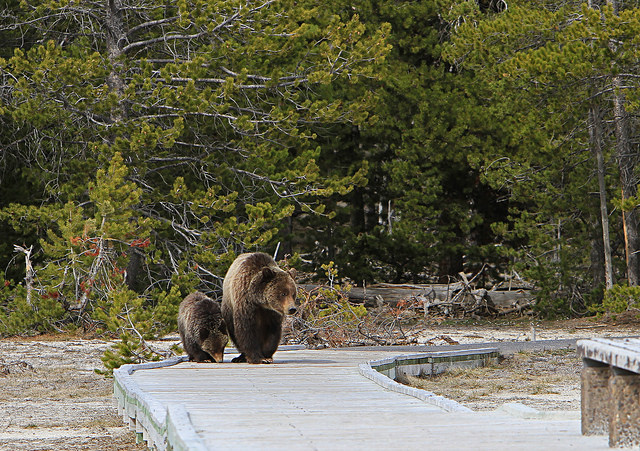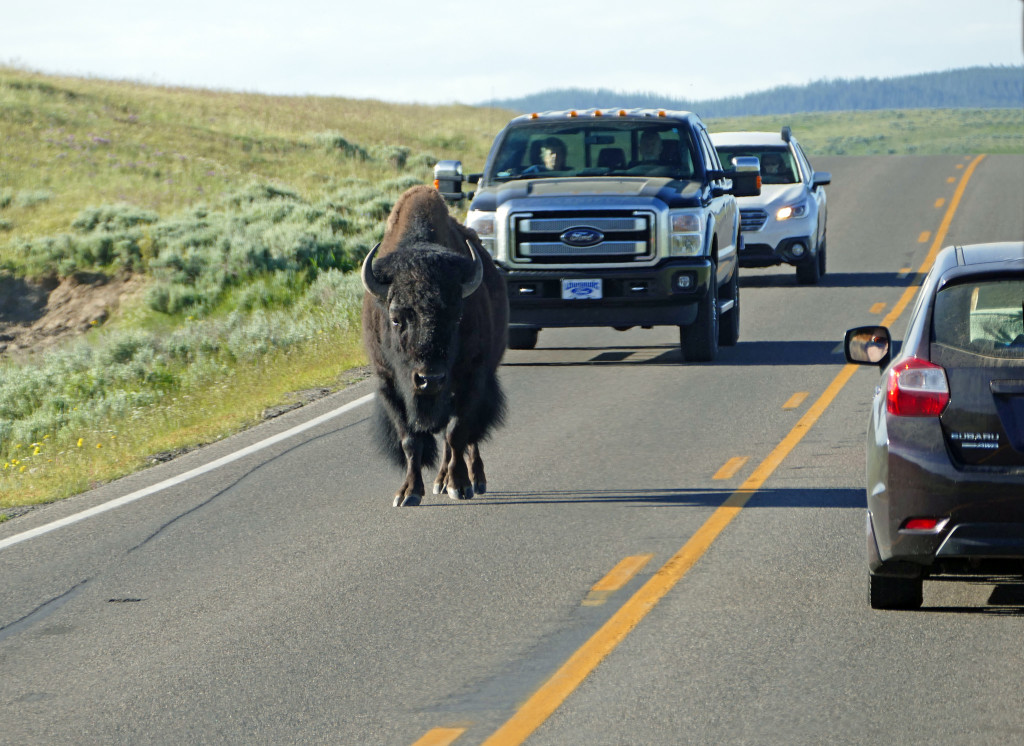We’re sure you’ve seen examples of visitor misbehavior before in Yellowstone National Park, firsthand or otherwise.
You know what we mean. This season alone, there have been several incidents, from visitors putting a bison in their car to tourists willfully stepping off the boardwalk in thermal areas. There was one incident of a tourist filling a water bottle with thermal water. And earlier this year, there was an unfortunate accident where a 23-year-old man died after falling into a hot spring several hundred yards off the pathway.
Visitor misbehavior has been a staple of Yellowstone for over a century and is endemic to the national park system as a whole. And according to the Associated Press, it’s on the rise:
Record visitor numbers at the nation’s first national park have transformed its annual summer rush into a sometimes dangerous frenzy, with selfie-taking tourists routinely breaking park rules and getting too close to Yellowstone’s storied elk herds, grizzly bears, wolves and bison.
Law enforcement records obtained by The Associated Press suggest such problems are on the rise at the park, offering a stark illustration of the pressures facing some of America’s most treasured lands as the National Park Service marks its 100th anniversary.
From Tennessee’s Great Smoky Mountains to the Grand Canyon of Arizona, major parks are grappling with illegal camping, vandalism, theft of resources, wildlife harassment and other visitor misbehavior, according to the records obtained through a Freedom of Information Act request.
In July alone, law enforcement rangers handled more than 11,000 incidents at the 10 most visited national parks.
In Yellowstone, rangers are recording more wildlife violations, more people treading on sensitive thermal areas and more camping in off-limit areas. The rule-breaking puts visitors in harm’s way and can damage resources and displace wildlife, officials said.
“I’d Throw It A Cookie”
More often than not, such as brushes with bison and elk, close encounters of the wild kind are driven less by willful ignorance as misplaced confidence. One such incident recently occurred in Yellowstone: John Gleason and his four small children crept up on a bull elk, resplendently attired with antlers “like small trees,” as it was grazing in a meadow. Other tourists joined in on the “fun,” but not everyone was pleased. From AP:
“They’re going to give me a heart attack,” said Gleason’s mother-in-law, Barbara Henry, as the group came within about a dozen yards of the massive animal.
The elk’s ears then pricked up, and it eyed the children and Washington state man before leaping up a hillside. Other tourists – likewise ignoring rules to keep 25 yards from wildlife – picked up the pursuit, snapping pictures as they pressed forward and forced the animal into headlong retreat.
[…]
Often the incidents go unaddressed, such as when Gleason and the children approached the bull elk with no park personnel around. Gleason said he was “maybe” too close but felt comfortable in the situation as an experienced hunter who’s spent lots of time outdoors.
These transgressions add to rangers’ growing workload that includes traffic violations, searches for missing hikers and pets running off-leash in parks intended to be refuges of untrammeled nature
“It’s more like going to a carnival. If you look at the cumulative impacts, the trends are not good,” said Susan Clark, a Yale University professor of wildlife ecology who has been conducting research in the Yellowstone area for 48 years. “The basic question is, ‘What is the appropriate relationship with humans and nature?’ We as a society have not been clear about what that ought to be, and so it’s really, really messy and nasty.”
Administrators feel similarly. Yellowstone Superintendent Dan Wenk told the AP that when he tells visitors the wildlife is, well, wild, “they look at me like I have three heads.”
The belief that wildlife are tame runs deep. Lisa Murrow of Washington State, for instance, told the AP that not only was she not afraid of Yellowstone’s wildlife, she wanted to get up close and personal with a grizzly bear. “I’d throw it a cookie,” she said.
Preventing Misbehavior
Although Yellowstone and other national parks strive to educate visitors on the risks of approaching wildlife and venturing off marked trails and boardwalks, the advice often falls on deaf ears. Or ears unwilling to hear such “impracticalities.” It’s their vacation, right?
At any rate, however the national park system decides to address visitor misbehavior, it will be an uphill battle, as visitor numbers rise across the system—and with them, citations and warnings. From the AP:
Inconsistent record keeping, including a recent switch to a new criminal offenses reporting system, makes it difficult to identify trends that apply uniformly across the major parks.
But the records reviewed by the AP reveal the scope of visitor misbehavior is huge. In Yellowstone, administrators and outside observers including Clark say the park’s problems have become more acute. That threatens its mission to manage its lands and wildlife “unimpaired” for future generations.
Beyond incidents that lead to citations are many more that result in warnings. More than 52,000 warnings were issued in 2015, up almost 20 percent from the year before.
[…]
Yellowstone boasts the most large, dangerous carnivores among those parks, but each has its risks. In Rocky Mountain National Park, it’s elk that become more aggressive during mating season. In Yosemite, it’s towering waterfalls where visitors insist on swimming near the edge. In the Grand Canyon, it’s squirrels habituated to humans and sometimes quick to bite an outstretched hand.
Wenk said the rise in popularity of social media complicates keeping visitors safe.
“You take a picture of yourself standing 10 feet in front of a bison, and all of a sudden a few hundred people see it, and it’s reposted – at the same time we’re telling everybody wildlife is dangerous,” Wenk said. “They get incongruous messages and then it happens. They get too close, and the bison charges.”
So-called “bison selfies” have become such a problem in fact that the CDC issued a report that stated, to the effect, “stop doing that. Immediately.” In 2015, five people were injured by bison lashing out at visitors who got too close.
 Yellowstone Insider Your Complete Guide to America's First National Park
Yellowstone Insider Your Complete Guide to America's First National Park








You must be logged in to post a comment.